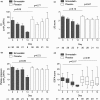Clinical review: Early treatment of acute lung injury--paradigm shift toward prevention and treatment prior to respiratory failure
- PMID: 22713281
- PMCID: PMC3580596
- DOI: 10.1186/cc11144
Clinical review: Early treatment of acute lung injury--paradigm shift toward prevention and treatment prior to respiratory failure
Abstract
Acute lung injury (ALI) remains a major cause of morbidity and mortality in critically ill patients. Despite improved understanding of the pathogenesis of ALI, supportive care with a lung protective strategy of mechanical ventilation remains the only treatment with a proven survival advantage. Most clinical trials in ALI have targeted mechanically ventilated patients. Past trials of pharmacologic agents may have failed to demonstrate efficacy in part due to the resultant delay in initiation of therapy until several days after the onset of lung injury. Improved early identification of at-risk patients provides new opportunities for risk factor modification to prevent the development of ALI and novel patient groups to target for early treatment of ALI before progression to the need for mechanical ventilation. This review will discuss current strategies that target prevention of ALI and some of the most promising pharmacologic agents for early treatment of ALI prior to the onset of respiratory failure that requires mechanical ventilation.
Figures




References
-
- Bernard G R, Artigas A, Brigham KL, Carlet J, Falke K, Hudson L, Lamy M, LeGall JR, Morris A, Spragg R. Report of the American-European Consensus conference on acute respiratory distress syndrome: definitions, mechanisms, relevant outcomes, and clinical trial coordination. Consensus Committee. J Crit Care. 1994;9:72–81. doi: 10.1016/0883-9441(94)90033-7. - DOI - PubMed
-
- Ventilation with lower tidal volumes as compared with traditional tidal volumes for acute lung injury and the acute respiratory distress syndrome. The Acute Respiratory Distress Syndrome Network. N Engl J Med. 2000;342:1301–1308. - PubMed
-
- Brower RG , Lanken PN, MacIntyre N, Matthay MA, Morris A, Ancukiewicz M, Schoenfeld D, Thompson BT. Higher versus lower positive end-expiratory pressures in patients with the acute respiratory distress syndrome. N Engl J Med. 2004;351:327–336. - PubMed
Publication types
MeSH terms
Substances
Grants and funding
LinkOut - more resources
Full Text Sources
Medical
Miscellaneous

